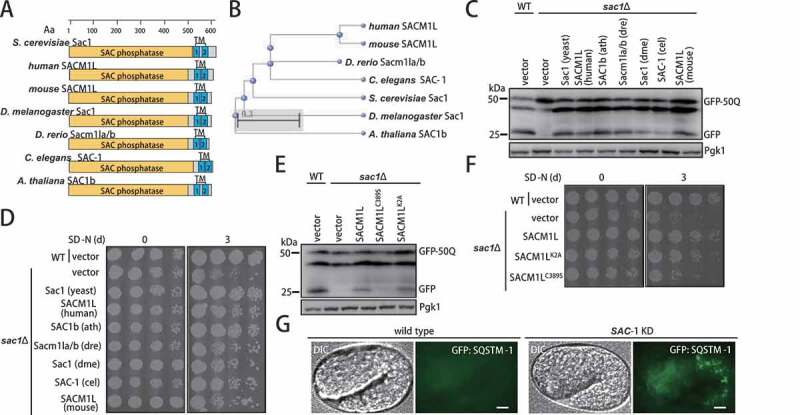Figure 5.

Sac1 was highly conserved across eukaryotes to function in autophagy. (A) Schematic map of protein domains of Sac1 proteins in yeast and higher eukaryotic organisms. S. cerevisiae: Saccharomyces cerevisiae, human: Homo sapiens, mouse: Mus musculus, D. melanogaster: Drosophila melanogaster, D. rerio: Danio rerio, C. elegans: Caenorhabditis elegans, A. thaliana: Arabidopsis thaliana. (B) Phylogenetic tree of Sac1 orthologs in different species. (C) Sac1 orthologs from complex eukaryotic species could restore autophagy in yeast sac1∆ cells. yeast: Saccharomyces cerevisiae, human: Homo sapiens, ath: Arabidopsis thaliana, dre: Danio rerio, dme: Drosophila melanogaster, cel: Caenorhabditis elegans, mouse: Mus musculus. (D) Expression of Sac1 orthologs rescued yeast cell from vulnerability to nitrogen starvation caused by lacking Sac1. (E) Human SACM1L depended on its phosphatase enzyme activity and Golgi-localization for restore of autophagy. GFP cleavage assays were performed using catalytic mutant (C389S) or Golgi-retention mutant (K2A) of human SACM1L. (F) Human SACM1L restored yeast cell resistance to starvation depending on its phosphatase enzyme activity and Golgi localization. (G) Autophagic substrate GFP::SQSTM1-labeled aggregates were ectopically accumulated in C. elegans embryos with SAC-1 knockdown. Representative images were shown. Scale bars: 5 μm
